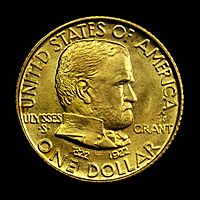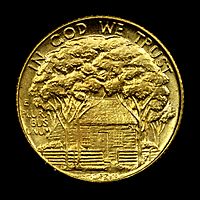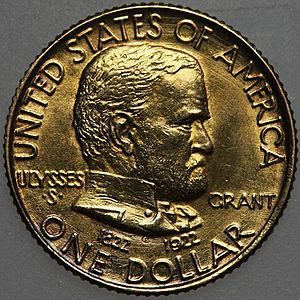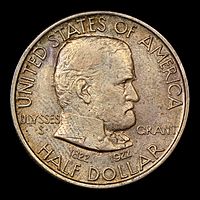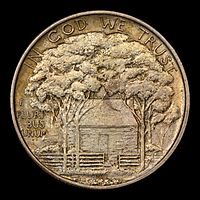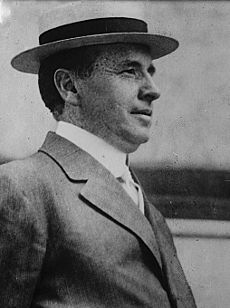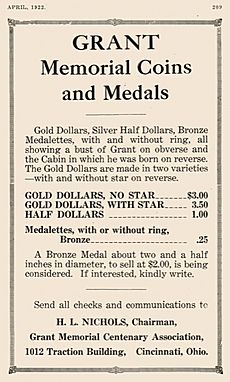Grant Memorial coinage facts for kids
The Grant Memorial coins are special gold dollars and silver half dollars made by the U.S. Mint in 1922. These coins were created to celebrate the 100th birthday of Ulysses S. Grant. He was a famous general during the American Civil War and later became the 18th president of the United States. Both the gold and silver coins have the same design, which was created by a sculptor named Laura Gardin Fraser.
A group called the Grant Commission wanted to sell these coins to raise money. They planned to use the money for projects at places important to Grant's life, like his birthplace and boyhood home. They hoped to sell 200,000 gold dollars. However, the U.S. Congress allowed only 10,000 gold coins to be made. Congress also approved 250,000 silver half dollars. To encourage more sales, the Grant Commission asked for 5,000 of the gold dollars to have a small, raised star on them. The Mint also added stars to some of the half dollars, even though they weren't asked to.
Most of the gold dollars and many of the half dollars were sold. Some half dollars that didn't sell were sent back to the Mint to be melted down. The half dollar coins with a star have always been quite valuable to collectors. Because they are rare, some fake versions have been made. The money raised from selling these coins helped to protect Grant's birthplace. However, other projects that were planned, like new buildings or roads, were not finished.
Contents
Who Was Ulysses S. Grant?
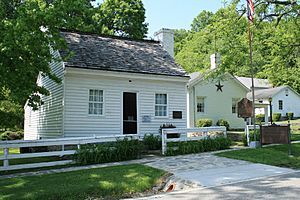
Hiram Ulysses Grant was born on April 27, 1822, in Point Pleasant, Ohio. His family moved to Georgetown, Ohio the next year. When he was older, his father helped him get into the U.S. Military Academy at West Point, New York in 1839. By mistake, his name was written down as Ulysses S. Grant, and he decided to keep that name.
Grant fought in the Mexican–American War. He left the Army in 1854 and tried different jobs, but didn't have much success. When the American Civil War began, he rejoined the military. He became very successful, winning many battles for the Union. In late 1863, President Lincoln made him the top general of the Union Armies. In April 1865, Grant's forces captured Richmond, Virginia. Soon after, Confederate General Robert E. Lee surrendered, which effectively ended the war. In 1868, Grant was elected the 18th president of the United States, and he served two terms.
The Ulysses S. Grant Centenary Memorial Association was formed in 1921. This group organized the celebrations for Grant's 100th birthday in Clermont County, Ohio. They wanted to create a special coin to help pay for these events. In the 1920s, the government didn't sell commemorative coins directly. Instead, Congress would choose an organization to buy the coins at their face value. This group would then sell them to the public for a higher price. For the Grant Memorial coins, this group was the Association, also known as the Grant Commission. Hugh L. Nichols was the chairman of this group.
How the Coins Became Law
A bill to create a Grant Memorial gold dollar was introduced in the House of Representatives on May 11, 1921. It was proposed by Charles C. Kearns from Ohio. The bill asked for 200,000 gold dollars to be made. The money would help build community centers in Georgetown and Bethel, Ohio. It would also help build a 5-mile road called the General Grant Memorial Highway. This road would connect New Richmond, Ohio to Point Pleasant.
The bill was sent to a special committee in the House. On August 13, the committee suggested some changes. For example, the Grant Commission would have to pay for the coin designs. The committee said that Grant had lived in both Bethel and Georgetown. They also noted that the road between New Richmond and Point Pleasant was hard to use. The report said the Grant Commission was ready to buy all the coins. They planned to sell them through banks in Ohio. The profits would pay for the birthday celebrations, the road, and possibly the community buildings.
The bill was discussed in the House on October 17, 1921. After some changes were agreed upon, a representative named Richard W. Parker asked if the Grant Commission would get the coins for free. He was told that the government would be paid the coins' face value. Thomas L. Blanton added that the U.S. government would not charge extra, but the Grant Commission could. Another representative, Otis Wingo, asked more questions. He learned that the gold coins would be made from gold the government already had. Also, the Commission would pay for the special tools (dies) used to make the coins. This meant there would be no cost to the government. After these discussions, the bill passed easily.
The bill then went to the Senate. A committee there changed the bill on January 23, 1922. They reduced the number of gold dollars to 10,000. They also added approval for 250,000 silver Grant Memorial half dollars. That same day, George P. McLean from Connecticut presented the bill to the Senate. Frank B. Willis from Ohio spoke in favor of it. He explained that the coins were for fundraising and would not cost the government anything.
Reed Smoot from Utah noticed that most of the bill had been rewritten. McLean explained that the House bill had asked for too many gold dollars (200,000). The committee thought it was not wise to use so much gold for coins that would not be used in everyday buying and selling. This satisfied Smoot. Then, Vice President Calvin Coolidge asked if anyone objected to discussing the bill. William H. King from Utah wondered if the coin would set a bad example or cost money. Willis promised that the Grant Commission would pay all costs. He said it was like other commemorative coin bills. Willis warned that if King objected, the bill might be delayed too much. Atlee Pomerene from Ohio spoke to King, explaining how important the bill was to Ohio. He also mentioned that the Commission was led by a respected former judge, Nichols. Coolidge asked again if there were any objections. Since there were none, the Senate approved the changes and passed the bill.
Because the House and Senate passed different versions, the bill went back to the House. On January 26, the House agreed to the Senate's changes. The bill then became law when President Warren G. Harding signed it on February 2, 1922.
Designing the Coins
In 1921, President Harding ordered that the Commission of Fine Arts (CFA) should give advice on public artworks, including coins. When the Grant coin bill passed, most CFA members were busy. So, the job of choosing an artist for the coin fell to James Earle Fraser. He was a sculptor on the CFA and had designed the famous Buffalo nickel. James Fraser chose his wife, Laura Gardin Fraser, to design the coins. She had already designed the Alabama Centennial half dollar in 1921.
On February 12, 1922, Laura Fraser wrote to the Director of the Mint, Raymond T. Baker. She thanked him for choosing her and said she was already working. She hoped to have the coin models ready for the next CFA meeting. She also asked for an official letter saying she was appointed to design the coins. This was because she had trouble getting paid for her work on the Alabama coin. At the CFA meeting on February 24, members saw the model for the front of the gold dollar and approved it. Laura Fraser finished her work soon after. On March 3, James Fraser wrote to the CFA chairman, saying he had checked the models and approved them. The full CFA agreed, and the gold coins began to be made in March.
What the Coins Look Like
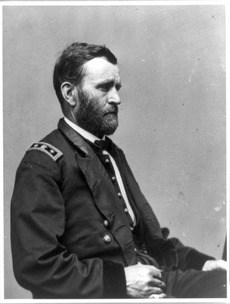
The gold and silver coins have almost the exact same design. The only difference is the words for their value (dollar or half dollar). For the front (obverse) of the coin, Laura Fraser used a photograph of Grant taken by Mathew Brady's studio. One historian, Don Taxay, said Fraser's design was "remarkable for its strength and character." On the coin, Grant wears a military coat, like he did during the Civil War. His short beard suggests he looks like he did after the war. Below Grant's image, you can see Fraser's initial "G" for her maiden name, Gardin. Some people think she used only one initial to avoid showing favoritism, since her husband was on the CFA. The front of the coin also shows Grant's name, the years of the centennial (1822-1922), the coin's value, and the country's name.
The back (reverse) of the coin shows Grant's birthplace in Point Pleasant. Fraser again used a photograph, showing the house before it was fixed up. The trees on the coin don't appear on a special medal made for Grant's birthday. At the time the coins were released, the Secretary of the Treasury, Andrew W. Mellon, mistakenly called the house a log cabin. He was confusing it with a different cabin Grant built later in his life. Frank Duffield, an editor of a coin magazine, said that the house on the coin looked small next to the trees. He thought a little less realism might have made the design better. However, he also said the coins were as good as any other commemorative coins of that time. Another expert, Arlie L. Slabaugh, said Laura Fraser's work was "fine quality." The words IN GOD WE TRUST and E PLURIBUS UNUM are on the back. But there are no words explaining what the picture is. As coin expert Anthony Swiatek said, "the design itself tells the story."
An art historian, Cornelius Vermeule, really liked Laura Fraser's design. He said that what might look like large letters in a photo actually looks beautiful on the real coin. He described Grant on the front as "his gruff self." He also said that the design was a great start for showing the Civil War on U.S. commemorative coins. About the back, he noted that her trees, house, and fence were made with amazing detail. He felt the texture of the leaves was one of the most subtle and lively parts of any American coin.
How the Coins Were Sold and Collected
Other special coins, like the Alabama and Missouri half dollars (both from 1921), had included a special mark on some coins. This was done so that collectors would buy two coins to get a full set. The Grant Commission wanted to do the same. They told the Mint to put a star on half (5,000) of the gold dollars. The star was only meant for the gold dollar. So, when some half dollars also came with a star, it was a "bonus" that surprised the committee. A letter from the Philadelphia Mint in March 1922 confirmed that 5,000 coins of each type would have a star. However, as late as May 1922, a coin magazine still reported there was only one type of half dollar. The star had no special meaning related to Grant. Its only purpose was to help sell more coins.
The Philadelphia Mint made 5,006 half dollars with the star and 95,055 without. It also made 5,016 gold dollars with the star and 5,000 without. All these coins were made in March 1922. The few extra coins (over the even thousands) were saved for testing later. The coins with stars were made first. Then, the star was removed from the coin-making tools (dies).
On April 15, Hugh Nichols wrote to the new Mint Director, Frank E. Scobey. He said his commission had started selling the coins. The gold dollar with a star sold for $3.50, and without a star for $3. The silver half dollar with a star sold for $1.50, and without a star for $1. Because there were many more silver coins than gold, the Commission required banks and coin dealers to buy 15 silver coins for every gold coin. For individuals, this ratio was lowered to 5 silver coins for every gold coin. Nichols offered to waive this rule if Scobey wanted to buy some coins.
In December 1922, Nichols placed an ad saying sales would end on January 1, 1923. He offered the no-star half dollar for 75 cents each if bought in groups of ten. The half dollar with a star was $1.50, and the gold dollar with a star was $3.50. By then, buyers no longer had to buy silver coins to get gold ones. The Grant Commission sold all the gold coins. However, they sent back 750 of the half dollars with stars and 27,650 of those without stars to be melted down. Not many of these coins went to people who weren't collectors. Many half dollars and most of the gold coins went to coin dealers and collectors.
The Grant Commission also wanted 150 of each coin type to be made in "proof condition." These are special, highly detailed coins made for collectors. But the Mint refused, saying they hadn't made proof coins in several years. Still, some proof versions of each coin might exist. One coin expert, Anthony Swiatek, believes there might be four of each.
Some of the Grant half dollars without stars were actually used as money. Because of this, they are worn from being passed around. As the coins became available to collectors, the half dollar with a star became very valuable. By 1935, it sold for $65, which was the highest value for any U.S. silver commemorative coin at that time. In that year, a dentist from New York bought hundreds of the no-star half dollars and punched stars into them to make fakes. Other fake versions have also been made.
By 1940, the half dollar without a star sold for $1.50, and with a star for $37. In 1950, these prices were $2.50 and $55. By 1970, they were $25 and $135. A popular coin guide, A Guide Book of United States Coins (also called the Red Book), listed the starred coins in 2018 for between $900 and $9,750, depending on their condition. The no-star coins were listed for between $110 and $1,000. The gold dollars with stars sold for about $12 in 1940, and those without stars brought $8. In 1950, these figures were $25 and $21. In 1970, they were $265 and $250. The Red Book lists the gold dollars with stars for between $1,500 and $2,250. The no-star gold pieces are listed for between $1,200 and $2,500.
The money from selling the coins was used to fix up Grant's birthplace and buy land around it. President Harding even spoke at a ceremony there. In 1989, a coin expert named Ric Leichtung visited the towns where the money was supposed to be used. He found Grant's birthplace in Point Pleasant and his old schoolhouse in Georgetown. But he noted, "There is no highway, no memorial buildings—just the two original structures moldering in Ohio's harsh winters and fierce summers." The Red Book also confirmed that "the buildings and highway never came to fruition."


